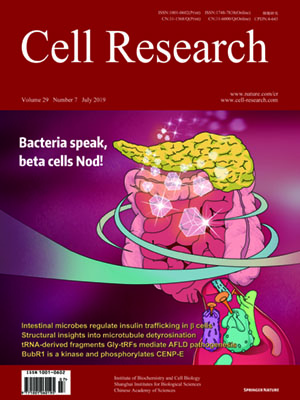
Volume 29, No 7, Jul 2019
ISSN: 1001-0602
EISSN: 1748-7838 2018
impact factor 17.848*
(Clarivate Analytics, 2019)
Volume 29 Issue 7, July 2019: 516-532 | Open Access
ORIGINAL ARTICLES
Intestinal lysozyme liberates Nod1 ligands from microbes to direct insulin trafficking in pancreatic beta cells
Qin Zhang1, Ying Pan1, Benhua Zeng2, Xiaojiao Zheng1, Haifang Wang1, Xueying Shen 1,3 , Hui Li 1,3 , Qian Jiang4, Jiaxu Zhao 5,6,Zhuo-Xian Meng7, Pingping Li4, Zhengjun Chen 5,6,8, Hong Wei9 and Zhihua Liu 1,10
1 Key Laboratory of Infection and Immunity, Institute of Biophysics, Chinese Academy of Sciences, Beijing 100101, China; 2Department of Laboratory Animal Science, College of Basic Medical Sciences, Third Military Medical University, Chongqing 400038, China; 3University of Chinese Academy of Sciences, Beijing 100049, China; 4The State Key Laboratory of Bioactive Substance and Function of Natural Medicines, Institute of Materia Medica, Chinese Academy of Medical Sciences & Peking Union Medical College, Beijing 100050,China; 5State Key Laboratory of Cell Biology, Shanghai Institute of Biochemistry and Cell Biology, Chinese Academy of Sciences, 320 Yueyang Rd, Shanghai 200031, China; 6Center for Excellence in Molecular Cell Science, Chinese Academy of Sciences, 320 Yueyang Rd, Shanghai 200031, China; 7Department of Pathology and Pathophysiology, School of Medicine, Zhejiang University, Hangzhou, Zhejiang 310058, China; 8ShanghaiTech Univ, Sch Life Sci & Technol, 100 Haike Rd, Shanghai 201210, China; 9Precision Medicine Institute, The First Affiliated Hospital, Sun Yat-sen University, Guangzhou, Guangdong 510080, China and 10Center for Excellence in Biomacromolecules, Chinese Academy of Sciences, Beijing 100101, China
Correspondence: Hong Wei (weihong63528@163.com) or Zhihua Liu (zhihualiu@ibp.ac.cn)These authors contributed equally: Qin Zhang, Ying Pan, Benhua Zeng
Long-range communication between intestinal symbiotic bacteria and extra-intestinal organs can occur through circulating bacterial signal molecules, through neural circuits, or through cytokines or hormones from host cells. Here we report that Nod1 ligands derived from intestinal bacteria act as signal molecules and directly modulate insulin trafficking in pancreatic beta cells. The cytosolic peptidoglycan receptor Nod1 and its downstream adapter Rip2 are required for insulin trafficking in beta cells in a cell-autonomous manner. Mechanistically, upon recognizing cognate ligands, Nod1 and Rip2 localize to insulin vesicles, recruiting Rab1a to direct insulin trafficking through the cytoplasm. Importantly, intestinal lysozyme liberates Nod1 ligands into the circulation, thus enabling long-range communication between intestinal microbes and islets. The intestine-islet crosstalk bridged by Nod1 ligands modulates host glucose tolerance. Our study defines a new type of inter-organ communication based on circulating bacterial signal molecules, which has broad implications for understanding the mutualistic relationship between microbes and host.
https://doi.org/10.1038/s41422-019-0190-3
FULL TEXT | PDF
Browse 1220


